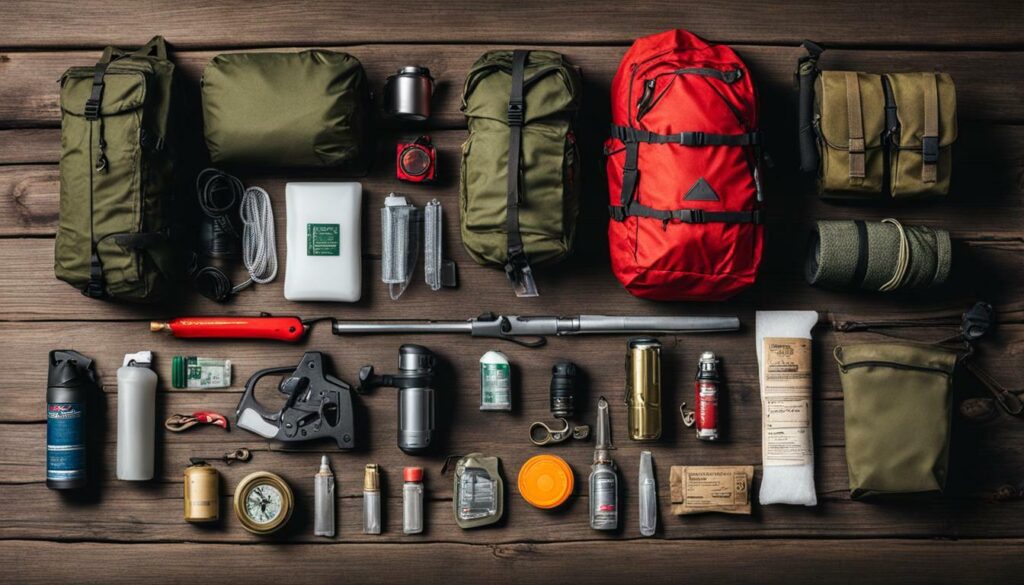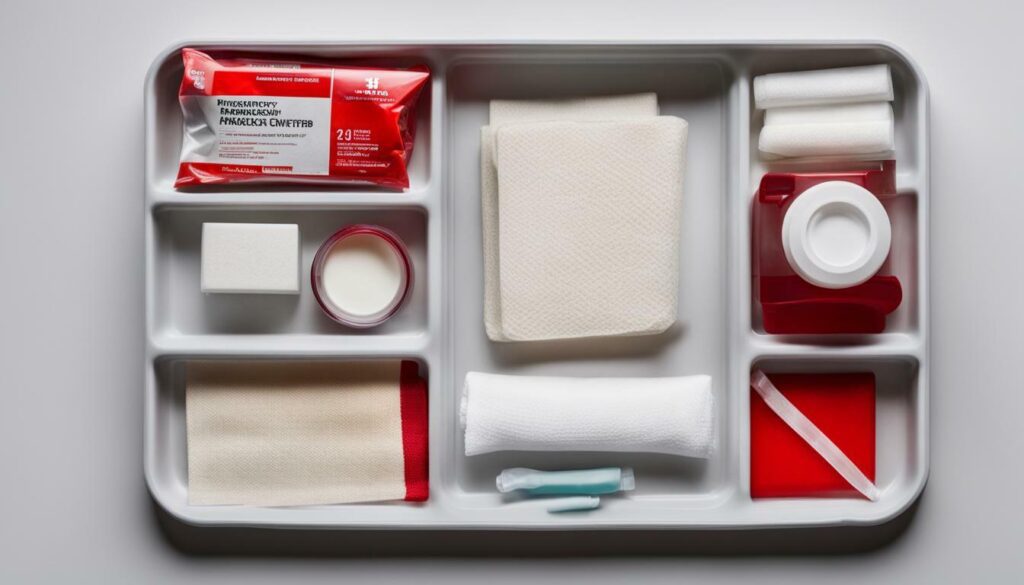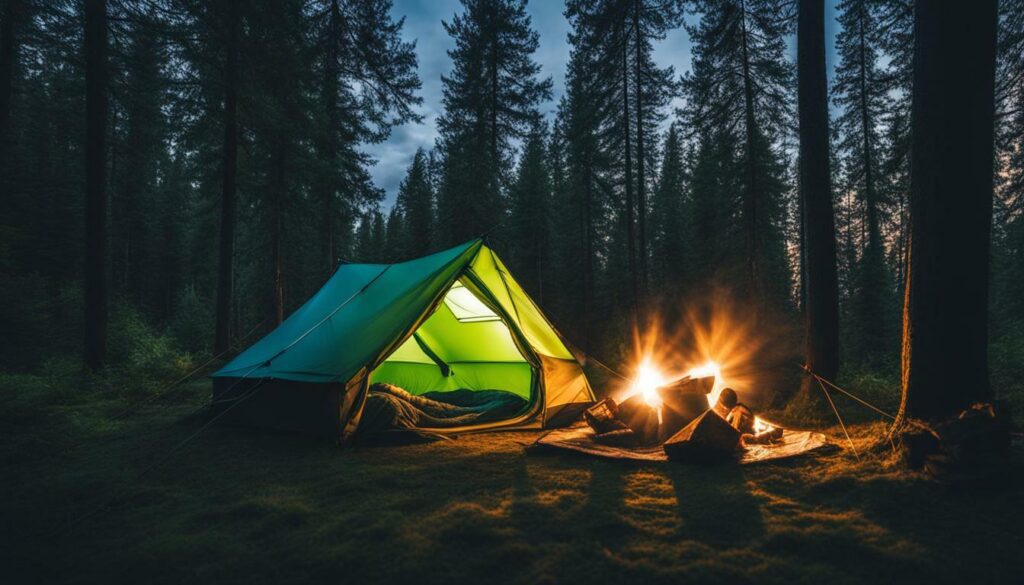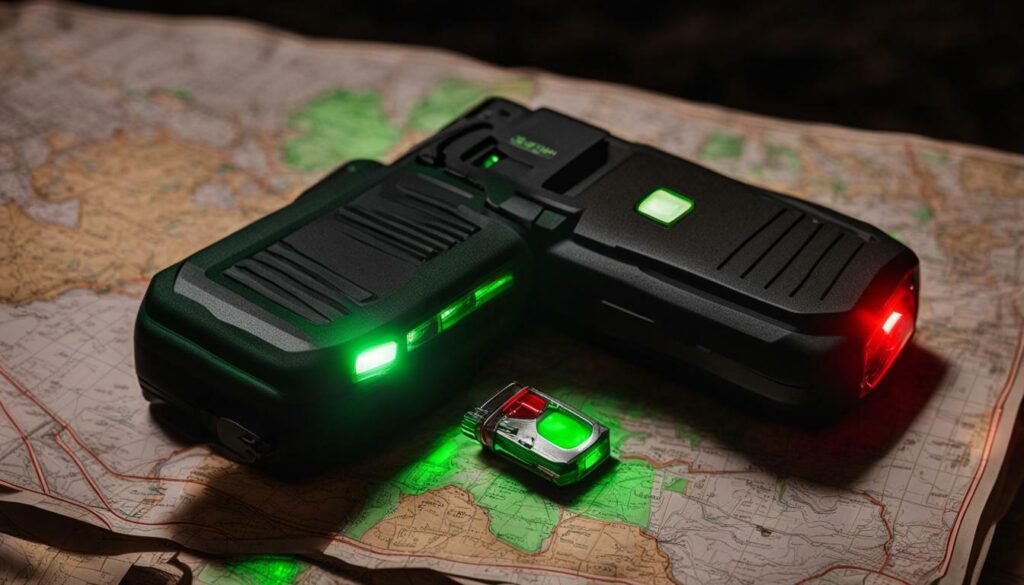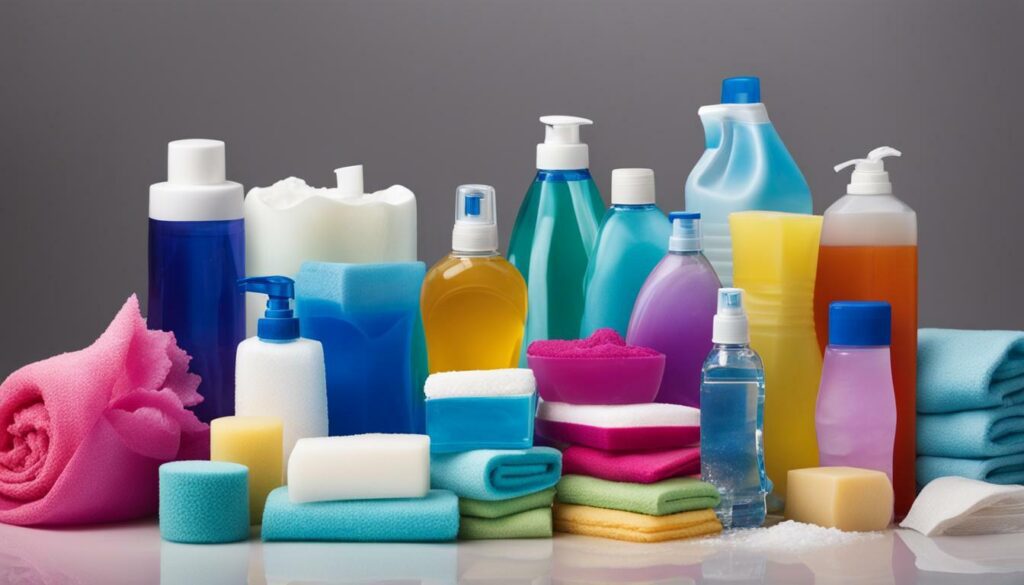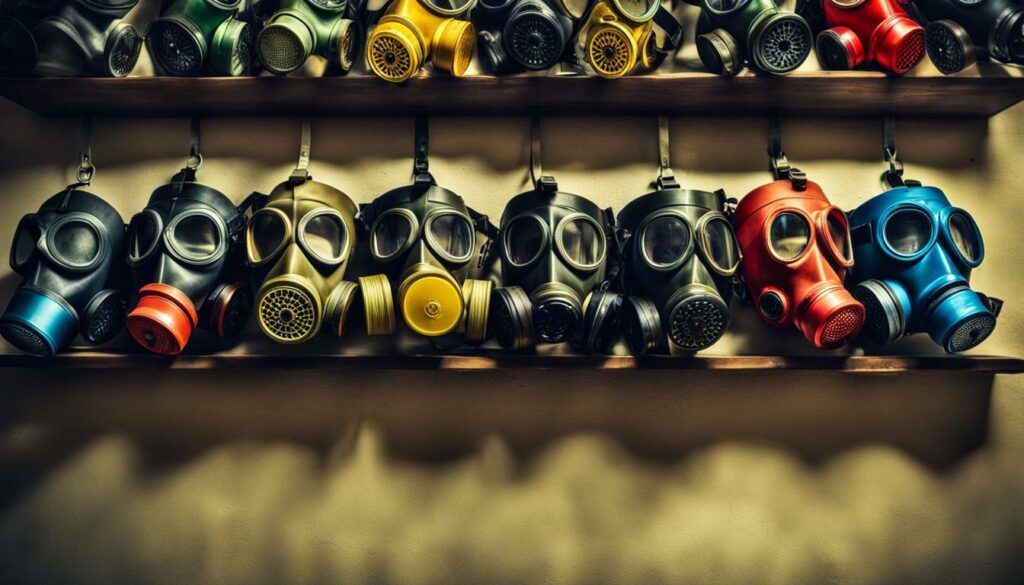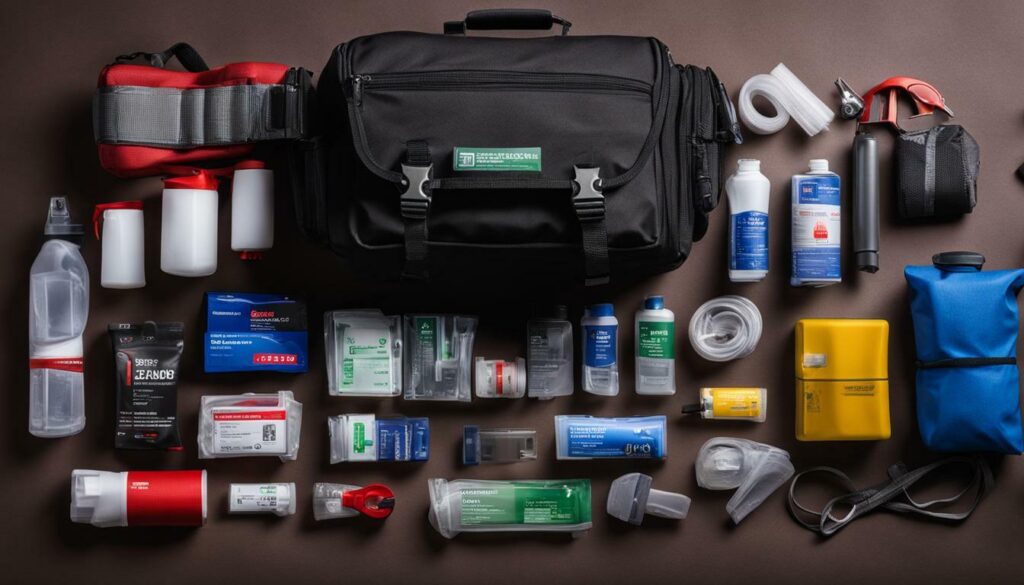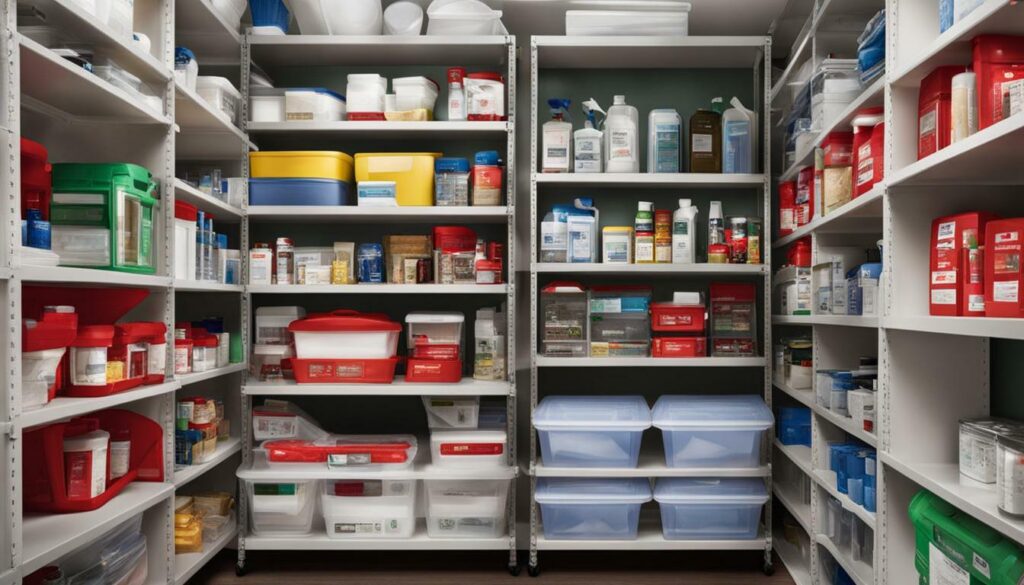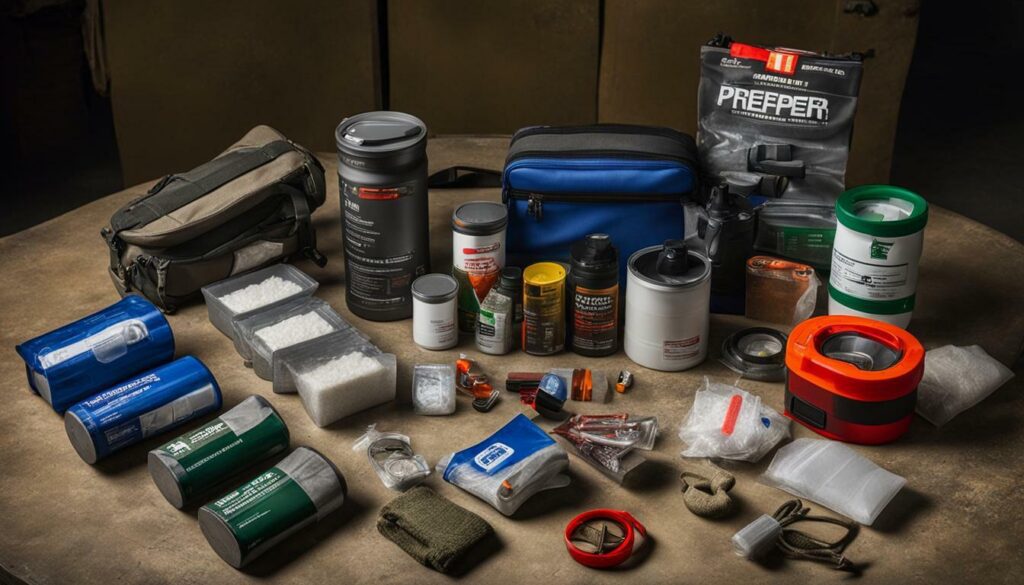
In times of emergency, being fully prepared is essential. The non-food prepper supplies list outlined below will ensure you are ready for any situation that may arise. From survival gear to first aid supplies, water and hygiene essentials to tools for utility, this comprehensive list covers all the prepping essentials you need for emergency preparedness.
Key Takeaways:
- Include essential survival gear like a multi-tool, quality knife, and flashlight.
- Don’t forget basic first aid supplies, such as a first aid kit and non-latex gloves.
- Ensure access to clean water with reusable water bottles and LifeStraw water filters.
- Stay warm and protected with extra blankets, a camping tent, and space blankets.
- Have the right tools for survival and utility, like a multi-tool with pliers and duct tape.
With these key items and more, you’ll be well-prepared to face any emergency situation. Remember to regularly check and update your emergency supply kit, and store it in multiple locations for easy access.
Essential Survival Gear Checklist for Prepping
When it comes to preparing for emergencies, having the right gear can make all the difference in your survival. Whether you’re facing a natural disaster, power outage, or any other emergency situation, having a well-equipped non-food prepper supplies list is crucial. Here is a comprehensive checklist of essential survival gear that should be included:
Survival Tools
- Multi-tool with pliers
- Quality knife or hatchet
- Flashlight with extra batteries
- Duct tape
- Paracord
First Aid Kit
- Basic first aid kit
- Survival medical handbook
- Non-latex gloves
- Pain relievers
Shelter and Warmth
- Extra blankets and warm clothing
- Rain ponchos
- Cooking pot
- Survival stoves
Water and Hydration
- Reusable water bottles
- LifeStraw water filters
Remember, this is just a starting point for your non-food prepper supplies list. Depending on your specific needs and circumstances, you may need to add or adjust items. It’s also important to regularly check and update your emergency supply kit to ensure everything is in working order and not expired. By being prepared with the right gear, you can increase your chances of staying safe and comfortable during any emergency.
In any emergency situation, having access to basic first aid supplies and medical knowledge is crucial for ensuring the well-being of yourself and others. Your non-food prepper supplies list should include a well-stocked first aid kit that can address a wide range of injuries and medical issues.
Here are some essential first aid supplies to include:
- Bandages, adhesive tape, and gauze for dressing wounds
- Tweezers and scissors for removing splinters or cutting bandages
- Antiseptic wipes or solution for cleaning wounds
- Non-latex gloves to protect yourself and others from contamination
- Pain relievers like acetaminophen and ibuprofen
- Allergy medications such as antihistamines
Additionally, it’s important to have a survival medical handbook that provides instructions on how to handle various medical emergencies when professional medical help may not be readily available. This handbook can be a valuable resource for understanding basic first aid procedures, recognizing symptoms, and administering appropriate treatments.
| First Aid Supplies | Survival Medical Handbook | Non-Latex Gloves |
|---|---|---|
| Bandages, adhesive tape, gauze | Instructions for basic first aid procedures | Safe and sterile protection |
| Tweezers, scissors | Recognizing symptoms | Preventing contamination |
| Antiseptic wipes or solution | Administering appropriate treatments | |
| Pain relievers, allergy medications |
Water and Hydration Essentials
Clean drinking water is a fundamental necessity in any emergency situation, and having the right tools to ensure access to safe hydration is essential. When preparing your non-food prepper supplies list, it is important to include items that can help you obtain and purify water.
A reusable water bottle should be at the top of your list, as it allows you to carry water with you at all times. Investing in a high-quality water bottle that is durable and easy to clean is a wise choice. Consider options that are BPA-free and have a wide-mouth opening for easy filling and cleaning.
In addition to a reusable water bottle, consider adding LifeStraw water filters to your kit. These portable water filters are compact and lightweight, making them ideal for outdoor and emergency use. They are designed to remove bacteria, parasites, and microplastics from water sources, ensuring that you have access to safe drinking water even in challenging conditions.
Water and Hydration Essentials Checklist:
- Reusable water bottles
- LifeStraw water filters
- Electrolyte drip drop
Having a reliable source of clean drinking water is crucial for your survival in any emergency situation. By including reusable water bottles and LifeStraw water filters in your non-food prepper supplies list, you can ensure that your hydration needs are met even when access to clean water is limited. Remember to regularly check and replace your water supplies to maintain their freshness and effectiveness.
| Item | Quantity |
|---|---|
| Reusable water bottles | 2 per person |
| LifeStraw water filters | 1 per person |
| Electrolyte drip drop | 1 box |
Shelter and Warmth
When faced with an emergency, having a reliable shelter and adequate warmth can greatly contribute to your comfort, safety, and well-being. In your non-food prepper supplies list, it is crucial to include items that will help you create a shelter and stay warm in challenging situations.
One essential item to have is extra blankets. These can provide insulation and protect you from cold temperatures, especially during power outages or when you are unable to access your regular heating source. Additionally, consider including a camping tent in your supplies. A tent can provide a secure and enclosed space, protecting you from the elements and ensuring a proper night’s sleep. If space is limited, a space blanket is a lightweight and compact option that reflects your body heat back to you, offering insulation and warmth.
To give you a better understanding of the essential shelter and warmth supplies, refer to the table below:
| Item | Description |
|---|---|
| Extra blankets | Provide insulation and warmth |
| Camping tent | Offers a secure and enclosed space |
| Space blanket | Lightweight and compact, reflects body heat |
Remember, in emergency situations, having a shelter and staying warm are essential for your overall well-being. Make sure to include these items in your non-food prepper supplies list and regularly check and update your emergency supply kit.
In the next section, we will discuss the importance of having the right tools for survival and utility in your non-food prepper supplies list.
Tools for Survival and Utility
In any emergency situation, having a set of reliable tools can help you tackle various tasks and challenges that may arise. Whether it’s building a shelter, fixing equipment, or performing essential repairs, the right tools are indispensable. When creating your non-food prepper supplies list, be sure to include these essential tools:
- Multi-tool with pliers: A versatile tool that combines multiple functions in one, including pliers, screwdrivers, knives, and more. It’s compact and easy to carry, making it a must-have in any survival kit.
- Quality knife or hatchet: A sharp, durable knife or hatchet can be used for various purposes, such as chopping wood, cutting rope, and preparing food. Look for one with a sturdy handle and a reliable blade.
- Duct tape: This versatile adhesive tape is known for its strength and durability. It can be used for quick repairs, securing items, and even creating makeshift shelters.
Having a reliable multi-tool, a quality knife or hatchet, and some duct tape can make a world of difference in a survival situation.
These tools are just the tip of the iceberg when it comes to the wide range of options available for survival and utility. Depending on your specific needs and situation, you may also consider adding items such as a flashlight, extra batteries, paracord, and a basic first aid kit to your non-food prepper supplies list. Remember, preparation is key, and having the right tools can greatly increase your chances of successfully navigating through an emergency.
| Tool | Function |
|---|---|
| Multi-tool with pliers | A versatile tool that combines multiple functions in one, including pliers, screwdrivers, knives, and more. |
| Quality knife or hatchet | A sharp, durable tool used for various purposes such as chopping wood, cutting rope, and preparing food. |
| Duct tape | A versatile adhesive tape known for its strength and durability, used for quick repairs, securing items, and creating makeshift shelters. |
Communication and Navigation
Clear communication and accurate navigation are vital in emergency situations, ensuring that you can stay connected and find your way to safety. Having the right communication and navigation tools in your non-food prepper supplies list is essential for preparedness. Here are some items to consider:
Walkie Talkies
Walkie talkies are a reliable means of communication during emergencies, especially when cell phone networks may be down. Look for models with a long range and multiple channels for versatile communication.
Compass
A compass is a timeless navigation tool that can help you determine direction and find your way when maps or GPS devices are not available. Ensure that you know how to use a compass effectively and consider a model with built-in magnifying glass and ruler for added functionality.
Maps
Include detailed maps of your local area and any areas you might potentially need to travel to during an emergency. Maps will give you a broader understanding of the terrain, help you identify potential hazards, and plan out alternative routes if needed.
| Communication | Navigation |
|---|---|
|
|
Summary:
Having reliable communication and navigation tools can make a significant difference in emergency situations. Walkie talkies provide a means of communication when other forms may be unavailable, while a compass and maps enable you to navigate effectively. Make sure to include these essentials in your non-food prepper supplies list for comprehensive emergency preparedness.
Personal Hygiene and Sanitation
Maintaining good personal hygiene and sanitation practices is crucial for preventing the spread of diseases and ensuring your well-being during an emergency. It’s important to include personal hygiene items in your non-food prepper supplies list to stay clean and healthy in challenging situations. Here are some essential items to consider:
- Toilet paper: Pack an adequate supply of toilet paper to maintain proper hygiene. It’s a basic necessity that should not be overlooked.
- Hand sanitizer: Access to clean water and soap may be limited during emergencies. Having hand sanitizer with at least 60% alcohol content can help keep your hands clean and prevent the spread of germs.
- Soap: Carry bars of soap or travel-sized liquid soap for washing your hands and body. Proper handwashing is crucial for maintaining good hygiene.
- Toothbrushes and toothpaste: Don’t neglect dental hygiene. Pack toothbrushes and toothpaste for regular brushing to keep your teeth and gums healthy.
- Antibacterial soap: In addition to regular soap, consider including antibacterial soap in your supplies. It can provide an extra level of protection against harmful bacteria.
Staying clean and maintaining good hygiene not only helps prevent the spread of diseases but also boosts morale and overall well-being during stressful times. Make sure to include these personal hygiene items in your non-food prepper supplies list to ensure you’re prepared for any emergency.
“Maintaining good personal hygiene and cleanliness is not just about physical health; it’s also about mental and emotional well-being during challenging times.”
| Personal Hygiene Items | Quantity |
|---|---|
| Toilet paper | 10 rolls per person |
| Hand sanitizer | At least 2 small bottles |
| Soap | 2 bars per person |
| Toothbrushes and toothpaste | 1 set per person |
| Antibacterial soap | 1 bar |
Self-Defense and Safety
In times of crisis, personal safety and the ability to protect yourself and your loved ones become paramount. Including self-defense items in your non-food prepper supplies list is essential for ensuring your safety in emergency situations. Here are some key self-defense items to consider:
- Gas masks: Protect yourself from harmful gases and chemicals with a reliable gas mask.
- Pepper spray: An effective tool for deterring attackers and providing you with a means of self-defense.
- Self-defense weapon: Choose a self-defense weapon that you feel comfortable using, such as a stun gun or a compact collapsible baton.
These items can provide an added layer of security and peace of mind during emergencies. Remember to familiarize yourself with the proper usage and storage instructions for each item to ensure their effectiveness when you need them most.
| Item | Description |
|---|---|
| Gas masks | Protects against harmful gases and chemicals. |
| Pepper spray | Effective tool for self-defense. |
| Self-defense weapon | Choose a weapon that suits your needs and skills. |
Having these self-defense items readily available can empower you to protect yourself and your loved ones during uncertain times. Incorporate them into your non-food prepper supplies list to enhance your emergency preparedness strategy.
Additional Considerations for Emergency Preparedness
Preparing for emergencies goes beyond the basic essentials, and there are additional items that can greatly enhance your level of preparedness. Having these additional items on hand can provide added comfort and peace of mind during challenging times. Here are some key considerations to include in your non-food prepper supplies list:
- Cash: In the event of a power outage or limited access to banking services, it’s important to have cash on hand for essential purchases or emergencies.
- Emergency Whistle: An emergency whistle can be a crucial tool for signaling for help or alerting others to your location in case of an emergency. Keep one with you at all times.
- Solar-Powered Devices: Investing in solar-powered devices, such as solar chargers or solar lanterns, can provide a sustainable source of energy during an emergency. These devices can help keep your essential electronics powered without relying on traditional electricity sources.
Remember to regularly check and update your emergency supply kit to ensure that all items are in good working condition and have not expired. Store your supplies in easily accessible, portable containers and consider keeping additional kits in multiple locations, such as at home, work, and in your car.
“Prepping Essentials: Recommended Supplies for Emergency Preparedness”
– Department of Homeland Security
| Item | Description |
|---|---|
| Cash | Keep small bills and coins on hand for emergency purchases or services that may not accept electronic payments. |
| Emergency Whistle | A high-pitched whistle is a simple but effective tool for attracting attention in emergency situations. |
| Solar-Powered Devices | Invest in solar-powered chargers, lanterns, or flashlights to ensure a reliable source of light and power during emergencies. |
Storing and Organizing Your Emergency Supplies
Properly storing and organizing your emergency supplies is essential for quick and easy access when disaster strikes. Having a well-structured storage system ensures that you can quickly locate and retrieve the necessary items when you need them the most. Here are some tips on how to store and organize your non-food prepper supplies list:
1. Choose the Right Containers
Invest in durable, waterproof containers that can withstand harsh conditions. Opt for plastic bins with tight-fitting lids to keep your supplies safe from moisture, pests, and dust. Clear containers are ideal as they allow you to easily see the contents without the need to open each one. Consider labeling the containers to further streamline the organization process.
2. Create a Systematic Layout
Designate specific areas or shelves for different categories of emergency supplies. For example, have a section dedicated to first aid supplies, another for tools and equipment, and so on. This way, you can quickly identify and access the necessary items when needed. Make sure to keep frequently used items within easy reach and reserve the lower shelves for heavier items.
3. Rotate and Check Supplies Regularly
Regularly check the expiration dates of food items, medications, and other perishable supplies. Rotate these items by using and replenishing them on a regular basis to ensure that you always have fresh and effective supplies on hand. Additionally, periodically review and update your non-food prepper supplies list to account for any changes in your needs or the specific requirements of your region.
4. Multiple Locations for Added Security
When it comes to emergency preparedness, it’s wise to have your supplies stored in multiple locations. This ensures that even if one location becomes inaccessible due to a disaster or emergency, you will still have access to vital resources. Consider keeping supplies at home, in your car, and at your workplace. Keep in mind any unique needs or situations you may have, such as if you have pets or family members with special medical needs.
| Storage Tip | Benefits |
|---|---|
| Use vacuum-sealed bags for clothing and blankets | Maximizes space and protects items from moisture |
| Keep a detailed inventory of your supplies | Helps you track what you have and what needs to be restocked |
| Store matches and lighters in a waterproof container | Ensures they remain dry and functional |
| Keep important documents in a fireproof safe | Protects important papers from being destroyed in a fire |
Remember, being well-prepared is key to effectively managing and surviving emergencies. By carefully storing and organizing your non-food prepper supplies list, you can ensure that you have everything you need readily available when disaster strikes.
Being fully prepared for any emergency requires careful planning and consideration of the essential non-food prepper supplies. Your emergency supply kit should include a comprehensive list of survival items, ranging from basic first aid supplies and shelter necessities to communication devices and self-defense tools.
Start by assembling the necessary survival gear, such as a multi-tool with pliers, a quality knife or hatchet, flashlight, and extra batteries. These tools will prove invaluable in various emergency situations. Additionally, remember to include basic first aid items, like a first aid kit, non-latex gloves, and a survival medical handbook, to address any injuries that may occur.
Water and hydration essentials should not be overlooked, as staying hydrated is crucial during emergencies. Include reusable water bottles, LifeStraw water filters, and electrolyte drip drops to ensure a clean and sufficient water supply. Shelter and warmth are equally important, so pack extra blankets, a camping tent, and space blankets to keep you protected from harsh weather conditions.
In addition to survival gear, consider communication and navigation tools, like walkie talkies, a compass, and maps, to stay connected and find your way in unfamiliar environments. Personal hygiene and sanitation items, such as toilet paper, hand sanitizer, and personal hygiene products, should also be included to maintain cleanliness and prevent the spread of diseases.
For self-defense and safety, pack self-defense items, gas masks, and pepper spray to protect yourself and your loved ones from potential threats. Lastly, don’t forget about additional considerations like cash, an emergency whistle, and solar-powered devices, which can be helpful in emergency situations.
Remember, regularly check and update your emergency supply kit to ensure that all items are in good condition and within their expiration dates. Store your supplies in easy-to-carry containers and keep them in multiple locations, such as your home, workplace, and car, for quick accessibility.
By following this non-food prepper supplies list, you can be better prepared for any emergency that may arise. Stay safe and be ready!
FAQ
Why is having a comprehensive non-food prepper supplies list important?
Having a comprehensive non-food prepper supplies list is important because it ensures that you are prepared for any emergency. It allows you to have the necessary items and equipment to survive and thrive during difficult situations.
What should be included in a non-food prepper supplies list?
A non-food prepper supplies list should include essential survival items such as a multi-tool with pliers, a quality knife or hatchet, flashlight, extra batteries, duct tape, basic first aid kit, paracord, extra blankets and warm clothing, rain ponchos, pain relievers, reusable water bottles, LifeStraw water filters, matches/lighter/lighter fluid, cooking pot, Ziploc bags, survival stoves, pocket fishing poles, bolt cutters, gas masks, walkie talkies, hand crank radio, self-defense items, flares, emergency whistle, survival pack, binoculars, compass, Goal Zero solar charger, camping tent, money, pepper spray, personal hygiene items, toilet paper, firestarter, and various medical supplies.
How often should I check and update my emergency supply kit?
It is recommended to check and update your emergency supply kit at least once a year or whenever there are changes in your family’s needs or circumstances. Regularly rotating perishable items and checking the expiration dates of medications is crucial to ensure that your supplies are always up to date and ready to use.
Where should I store my non-food prepper supplies kit?
It is advisable to store your non-food prepper supplies kit in easy-to-carry containers and keep them in multiple locations such as your home, workplace, and car. This ensures that you have access to essential supplies no matter where you are during an emergency.
What is the importance of personal hygiene and sanitation items in emergency preparedness?
Personal hygiene and sanitation items are crucial in emergency preparedness as they help maintain cleanliness, prevent the spread of diseases, and promote overall hygiene. It is vital to include items such as hand sanitizer, toilet paper, soap, and other personal hygiene products in your non-food prepper supplies list.

